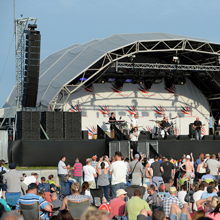 |
| The system was a combination of X2 line-array elements, along with X12-128 subs and TG amps |
The legendary British Grand Prix welcomed a record crowd of over 140,000 fans to the Silverstone racetrack on July 5th. Along with the triumph of Lewis Hamilton, thousands of attendees also witnessed the UK premiere of the new Electro-Voice X-Line Advance line-array loudspeaker system. Neal Allen of Merlin PA relied on 30 X2 line-array elements, along with X12-128 subs and TG amps, for acts including Madness, Deacon Blue, Nik Kershaw and Alesha Dixon. Electro-Voice NetMax N8000 controllers and an OMNEO network ensured the sound reinforcement system ran like clockwork.
“The premiere of a new system is always exciting,” says Neal Allen, owner of Merlin PA and responsible for the sound concept and realisation. “But after hearing the system for the first time in March, I was more than confident that it would blow the audience away.” Allen’s prediction proved to be right during this UK debut deployment: “The X2 provided us with a fantastic combination of high sound pressure, extended high-frequency response and linear low-frequency output.”
Ensures high-output capability in low frequencies
Allen opted for a total of 30 X2 line-array elements to each side of the stage, with 18 X12-128 subs ensuring extremely high-output capability in the low frequencies. “The subs are designed to acoustically match the X2 top cabinets. And, at the same time, thanks to the flexibility they offer in terms of configuration, the subs also allow for easier system design and setup,” comments Allen. 12 XLE181 compact line-array elements complemented the X2 speakers for far stage left and serviced the interactive entertainment village. 36 TG-7 power amplifiers drove the main system; Xw15A wedges ensured first-class foldback on stage.
Allen and his team connected the system to three NetMax N8000 digital matrices via an OMNEO network. “Using a Dante backbone and NetMax digital input cards, we integrated all FOH consoles into the system. This way we didn’t have to convert the signals from analogue to digital and back several times, but remained entirely on the digital level – a huge advantage in terms of sound quality.”




